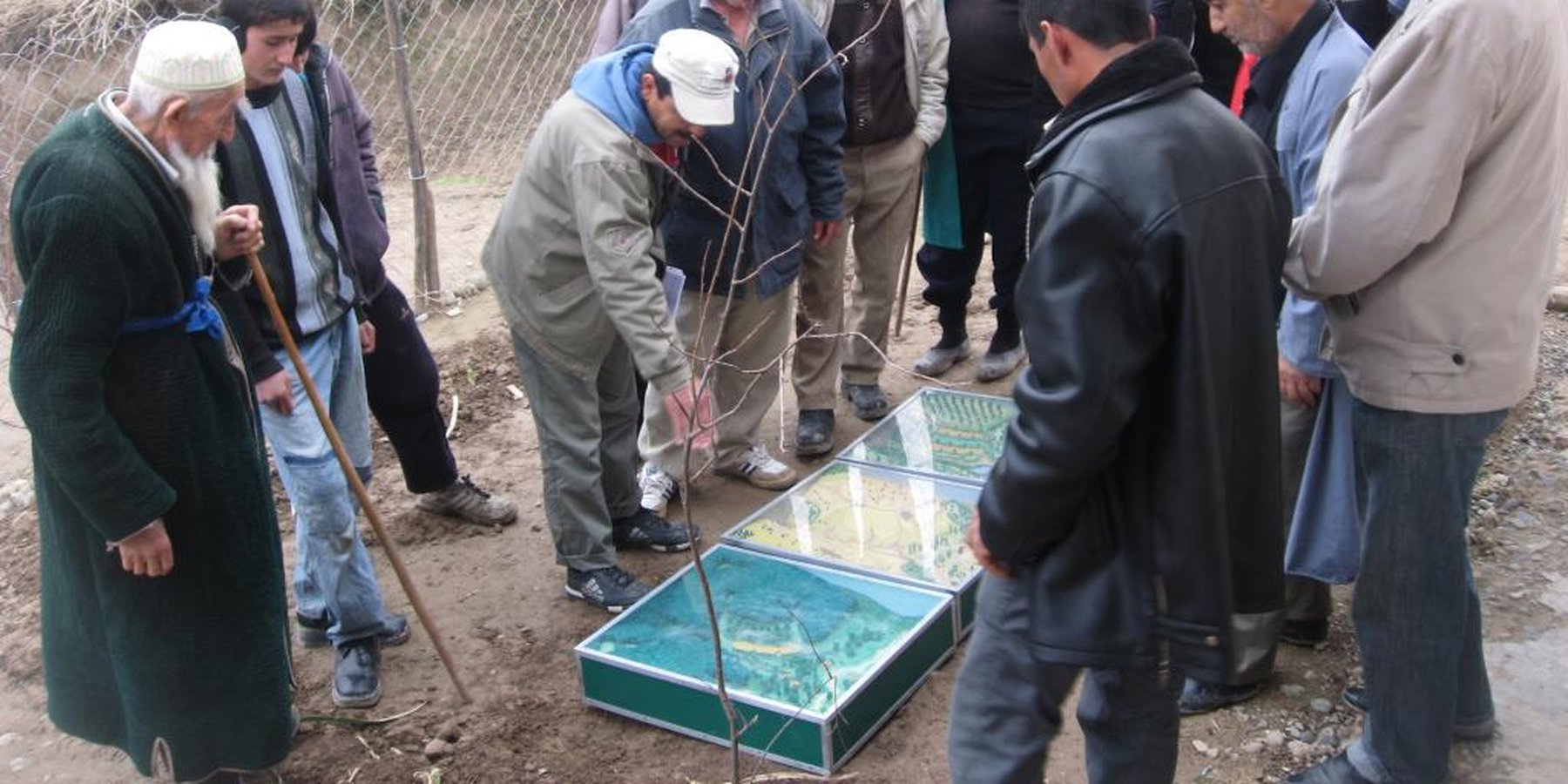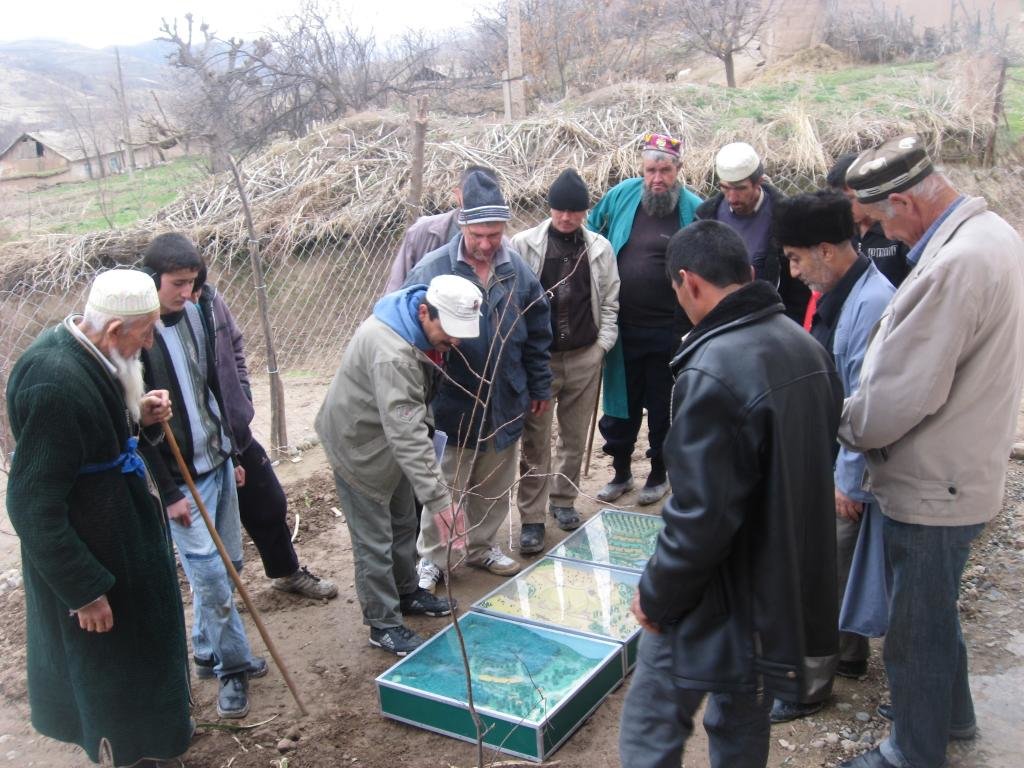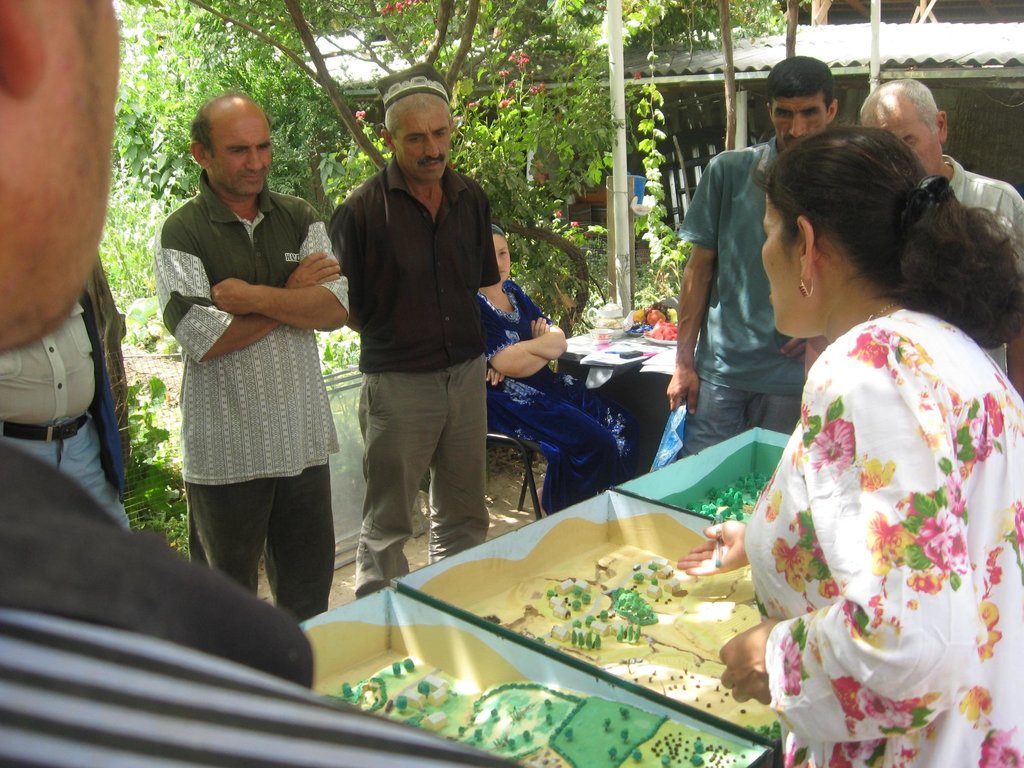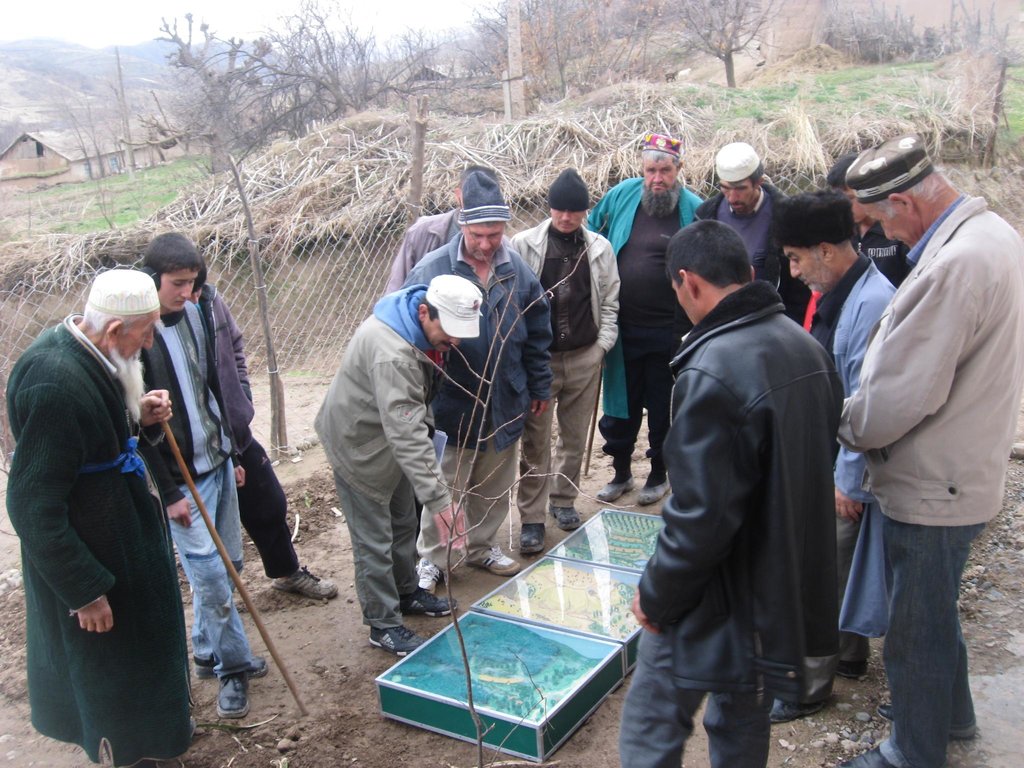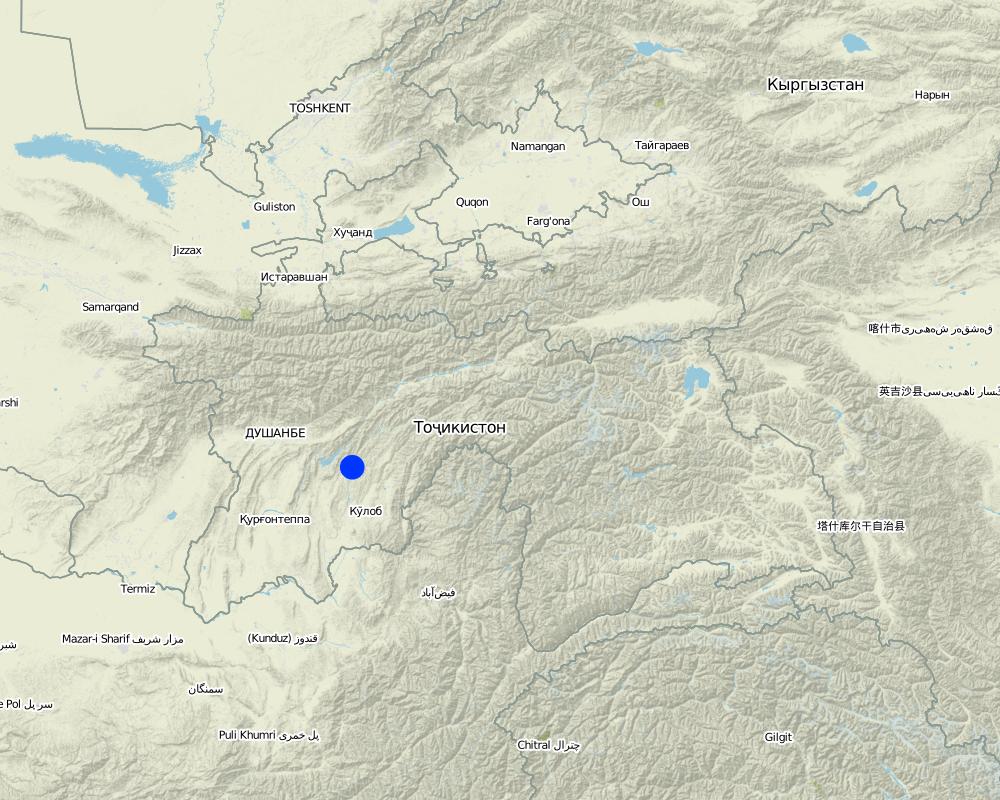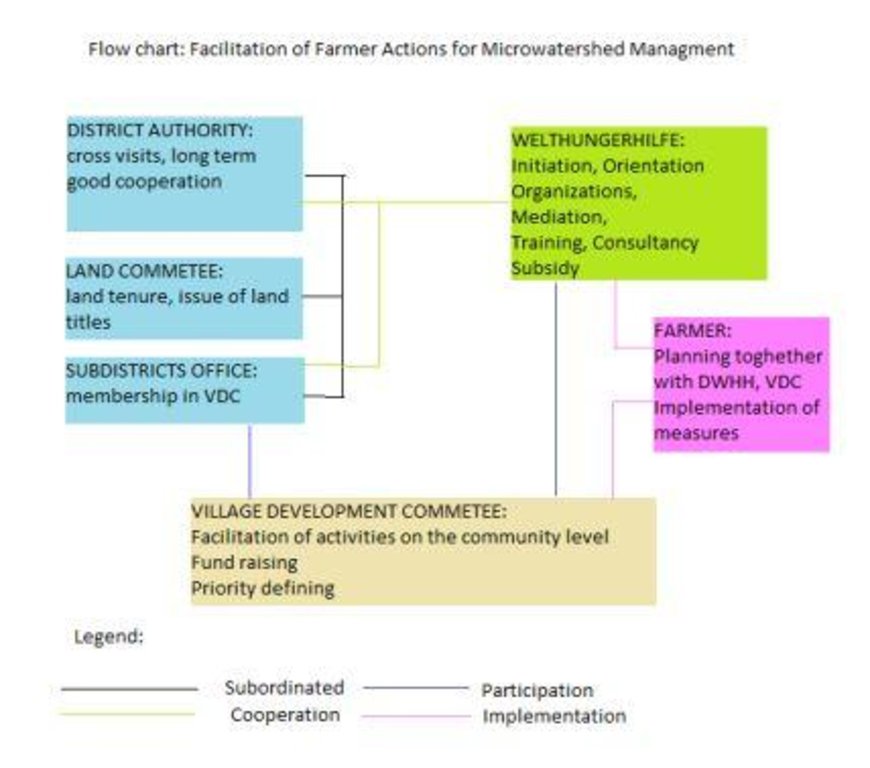Facilitation of micro-watershed management for farmers [塔吉克斯坦]
- 创建:
- 更新:
- 编制者: Manuchehr Rakhmatdzhonov
- 编辑者: –
- 审查者: David Streiff, Alexandra Gavilano
Фасилитасияи амалиётхои дехкон барои идораи микрохавза
approaches_2443 - 塔吉克斯坦
查看章节
全部展开 全部收起1. 一般信息
1.2 参与方法评估和文件编制的资源人员和机构的联系方式
SLM专业人员:
SLM专业人员:
SLM专业人员:
Bronkal Daniel
daniel.bronkal@welthungerhilfe.de
德国
有助于对方法进行记录/评估的机构名称(如相关)
Deutsche Welthungerhilfe - 塔吉克斯坦1.3 关于使用通过WOCAT记录的数据的条件
编制者和关键资源人员接受有关使用通过WOCAT记录数据的条件。:
是
1.4 SLM技术问卷的参考
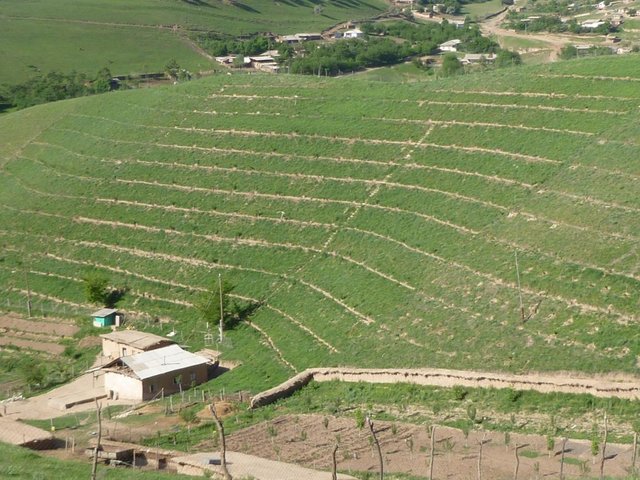
Gradual development of bench terraces from contour ditches [塔吉克斯坦]
Use of the SLM technology facilitates the development of bench terraces from contour channels by gradually removing soil material up the slope for an estimated 5 years until the terraces on the slope reach a desired width of 1.2 m.
- 编制者: Manuchehr Rakhmatdzhonov
2. SLM方法的描述
2.1 该方法的简要说明
Relying on integrated watershed management principles, farmers were assisted by the project to implement soil and water conservation measures in a microwatershed.
2.2 该方法的详细说明
该方法的详细说明:
Aims / objectives: To strengthen the capacity of the community to plan and implement integrated natural resource management approaches, at micro watershed level in sustainable ways. These include; conserving soil by introducing actions to rehabilitate the eroded land, stop gully formation resulting from water run-off; enable water retention to secure soil moisture for a longer time period; mitigate effects of overstocking resulting in overgrazing; hoof erosion and soil compaction; reverse inappropriate agriculture practices towards more efficient and environmentally friendly management types; enable better employment and higher income generation to improve the livelihood standards and food security.
Methods: The project facilitated the following activities: Farmer participation, and using their initiative, community involvement in the planning, fundraising and implementation. Farmers increased their own contribution for material inputs, and a greater than 50% rate of adoption of the innovation was seen. The project also funded 'on the job' training, technical support, consultancy, and mediation of communication between parties.
Stages of implementation: 1. Awareness raising, 2. On the job training, 3. Watershed management activity planning, 4. Implementation, 5. Monitoring, 6. Evaluation, 7. Readjustment based on results, 8. Further replication in new area
Role of stakeholders: The DWHH Project had a leading role in initiation, orientation, awareness raising, mobilisation, training, consultancy, input provision and mediation of communication to land committee. Farmers have been actively participating, have provided labour input / financial contribution, provided indigenous knowledge and skills. Local authorities - providing land titles, participation in planning and decision making process Village Development Committee (VDC) - community mobilisation, information dissemination, input / finance documentation, fund raising.
Other important information: There are 5 households in the microwatershed. Almost 40 people live in all HH, all are Tajiks. Members of all households took part in discussion rounds and training. Non of HHs were strong enough to implement measures on own funds. One HH has rejected implementation of measures, due lack of capacity and lack of trust of the project's success. Women: farmers came to the discussions together with their wives, women took part in training, in implementing almost all of the adoption measures, and equally benefited from the project. However, they were not involved in decision making.
2.3 该方法的照片
2.5 采用该方法的国家/地区/地点
国家:
塔吉克斯坦
区域/州/省:
Tajikistan, Khatlon
有关地点的进一步说明:
Baljuvon / Khirob
Map
×2.6 该方法的开始和终止日期
注明开始年份:
2009
终止年份(若不再采用该方法):
2011
2.7 方法的类型
- 最近的本地倡议/创新
2.8 该方法的主要目的/目标
The Approach focused mainly on SLM with other activities ( land use change, resource conservation, capacity building, focus on low cost local material, income generation, on the job training)
To assist farmers in the planning and implementation of activities for the conservation and improvement of the local land, to enable conditions for replication of the approach/technology, and to improve food production, and in the long run provide income generation.
The SLM Approach addressed the following problems: Lack of land tenure rights implementation. Nominal state farm reorganisation. Low agricultural production - lands depleted of nutrients, very low yields, no crop rotation, overgrazing. Soil degradation, progressing land mass transport, gully formation. Lack of technical knowledge and awareness of soil & water conservation measures. Lack of cash to invest in development of land - just limited capacity to invest but need external financial input. Conflict over land use - livestock owners are against land enclosures. Poverty - underlying cause of general lack of potential to invest in development.
2.9 推动或妨碍实施本办法所适用的技术的条件
财务资源和服务的可用性/可得性
- 阻碍
Technology implementation has required a major investment for imported materials, like a metal net for fencing or fuel. Most farmers could not afford themselves to buy costly inputs. Moreover such inputs were rarely available on the local market.
Treatment through the SLM Approach: The INGO covered the costs of 50% of each action, here mainly higher price inputs were paid off. The low-cost approach fits the financial capacity of the target group.
机构设置
- 阻碍
Capacities of communities and local authorities to jointly plan and implement SLM activities at micro-watershed level was weak.
Treatment through the SLM Approach: Knowledge improved on the complex interrelations in natural ecosystems (farmers and staff of local authorities). Project cooperation was not limited to those interested, there was inclusion of gov. structures (agriculture, land committee, ecology) committ
法律框架(土地使用权、土地和水使用权)
- 启动
The existing land ownership, land use rights / water rights moderately helped the approach implementation: On going legislative development in land tenure and farming provides good opportunities for implementation of the approach. But, ongoing nominal farm reorganisation and corruption at the local level, together with farmers reduced awareness of their land use rights requires more effort, time and funds in the application of SLM approaches. In this situation, DWHH has a good reputation in the district administration and with locals and so this helped overcome many barriers more easily.
- 阻碍
Implementing the land tenure law and the privatisation of state farms is still a difficult process with many inconsistencies for people claiming a land title in the area.
Treatment through the SLM Approach: There are a few instances where the project was able to support farmers in getting land-titles to degraded land plots which they then had to rehabilitate using SLM technologies.
了解SLM,获得技术支持
- 阻碍
Treatment through the SLM Approach:
3. 相关利益相关者的参与和角色
3.1 该方法涉及的利益相关者及其职责
- 当地土地使用者/当地社区
Village Development Committee, farmers
Men have played bigger role in the organisation of activities, in the implementation of more manual work, whereas, women took part in the lighter work and in routine maintenance.
Most of the participating households live below the poverty line.
Farmers joined under one microwatershed approach, male (wife assisted), middle age, Tajiks, rural middle class.
- SLM专家/农业顾问
Project TAJ1068 staff, and an international consultant
- NGO
Deutsche Welthungerhilfe
- 地方政府
Subdistrict, District Heads, Agriculture, Land committees, Forestry department
3.2 当地土地使用者/当地社区参与该方法的不同阶段
| 当地土地使用者/当地社区的参与 | 指定参与人员并描述活动 | |
|---|---|---|
| 启动/动机 | 互动 | farmers meeting through VDC, orientation explaining goals, objectives, advertising in the local news paper, information boards in 6 watersheds |
| 计划 | 互动 | on site planning with farmers |
| 实施 | 互动 | training on the job, material input and labour provision, cross visits |
| 监测/评估 | 互动 | data input, open to monitoring, communication on ongoing activities, collaboration while monitoring and evaluation |
| Research | 互动 | collaboration in the test for Acacia seed germination on the plot |
3.3 流程图(如可用)
具体说明:
Flow chart depicts the major actors involved during implementation of the approach. The relationship between stakeholders and primary functions is described as well.
作者:
Manuchehr Rakhmatdzhonov (16, Firdavsi Street 734003, Dushanbe)
3.4 有关SLM技术选择的决策
具体说明谁有权决定选择要实施的技术:
- 主要是SLM专家,咨询土地使用者之后
解释:
Decisions on the method of implementing the SLM Technology were made by mainly by SLM specialists with consultation of land users. Focused on principles of farmer participation, self motivation and self help.
4. 技术支持、能力建设和知识管理
4.1 能力建设/培训
是否为土地使用者/其他利益相关者提供培训?:
是
明确受训人员:
- 土地使用者
- 现场工作人员/顾问
- local land and agriculture departments, village development committee
如果相关,请说明性别、年龄、地位、种族等。:
Land users: 5 men, 5 women, 30 to 50 years old, all Tajiks, all families.
培训形式:
- 在职
- 示范区域
- 公开会议
涵盖的主题:
Use of the A-frame, watershed model, tree planting in contour ditches, intercropping
4.2 咨询服务
土地使用者有权使用咨询服务吗?:
是
指明是否提供了咨询服务:
- 在土地使用者的土地上
说明/注释:
A chain of meetings with international consultants from India and Nepal: Key elements: consultation on watershed concepts and watershed choice, capacity building in strategy design , draft development plan for watershed management
The consultants were : Yashvant Tkhakur, India; Jaganat Joschi, Nepal
Advisory service is inadequate to ensure the continuation of land conservation activities; the govenment branches need more development and organisation to become able to manage land conservation activities; an independent advisory service is not in place, the only potential still exists within the DWHH Project
4.3 机构强化(组织发展)
是否通过这种方法建立或加强了机构?:
- 是,少许
具体说明机构的强化或建立程度:
- 本地
具体说明支持类型:
- 能力建设/培训
提供进一步细节:
Village development committee (VDC), use of locally available resources, focus on low cost
4.4 监测和评估
监测和评估是该方法的一部分吗?:
是
注释:
area treated aspects were ad hoc monitored by land users through observations; indicators: space used for technology
economic / production aspects were regular monitored by project staff through measurements; indicators: fodder produced cent/ha, vegetables
socio-cultural aspects were ad hoc monitored by project staff through observations; indicators: labour availability, health status
technical aspects were ad hoc monitored by project staff through observations; indicators: tree planting
bio-physical aspects were ad hoc monitored by project staff through observations; indicators: soil degradation, gully formation
no. of land users involved aspects were ad hoc monitored by project staff through observations; indicators: monthly trends, how hardworking they were, gender
management of Approach aspects were ad hoc monitored by land users through observations; indicators: technology adaptation based on own experience
There were no changes in the Approach as a result of monitoring and evaluation: None
There were few changes in the Technology as a result of monitoring and evaluation: Change of the design - adjustment of the contour boundary based on experience on the plot; Adjusting of tree planting in contour ditches according to the topography
4.5 研究
研究是该方法的一部分吗?
是
明确话题:
- 技术
提供进一步的细节,并指出是谁做的研究:
Tests were completed on the germination of Acacia seeds in two different setups: on the demo plot of the project and on the farmers plot.
Research was carried out both on station and on-farm
5. 融资和外部物质支持
5.1 该方法中SLM组成部分的年度预算
如果不知道准确的年度预算,请给出一个范围:
- 2,000-10,000
注释(例如主要的资助来源/主要捐助者):
Approach costs were met by the following donors: international non-government (material input: tools, fencing, planting material, diesel. etc.): 50.0%; local community / land user(s) (the rest of material input, labour, time (mainly low cost inputs)): 50.0%; other
5.2 为土地使用者提供财政/物质支援
土地使用者是否获得实施该技术的财政/物质支持?:
是
如果是,请具体说明支持的类型、条件和提供者:
50% of activities were subsidised by the DWHH Project TAJ1068
5.3 对特定投入的补贴(包括劳动力)
- 设备
| 具体说明哪些投入得到了补贴 | 程度如何 | 对补贴做出具体说明 |
|---|---|---|
| 工具 | 部分融资 | hand tools |
- 农业
| 具体说明哪些投入得到了补贴 | 程度如何 | 对补贴做出具体说明 |
|---|---|---|
| 种子 | 部分融资 | |
| manure | 部分融资 | |
- 建筑
| 具体说明哪些投入得到了补贴 | 程度如何 | 对补贴做出具体说明 |
|---|---|---|
| metal net | 充分融资 | |
- 基建
| 具体说明哪些投入得到了补贴 | 程度如何 | 对补贴做出具体说明 |
|---|---|---|
| 学校 | 部分融资 | school, 2 rooms thermo insulated |
- 其它
| 其它(具体说明) | 程度如何 | 对补贴做出具体说明 |
|---|---|---|
| Fuel, diesel, oil | 部分融资 | 1/4 of the need |
如果土地使用者的劳动力是一项重要的投入,那么是不是:
- 自愿
注释:
Rennovation of the chool for the children was a strong and vital argument demanding considerable investment. This was competed with the implementation of the SLM technology, where farmers had to make a choice; either spend the available funds for the school or continue with the SLM. The project has provided partial financial and technology support to farmers which made it easy to overcome the school situation and concentrate again on SLM activities.
5.4 信用
是否根据SLM活动的方法给予信用值?:
否
5.5 其它激励或手段
是否有其他激励措施或工具用于促进SLM技术的实施?:
是
如果是,请具体说明:
Village development committee (VDC), use of locally available resources, focus on low cost
6. 影响分析和结论性陈述
6.1 方法的影响
该方法是否帮助土地使用者实施和维护SLM技术?:
- 否
- 是,很少
- 是,中等
- 是,支持力度很大
Most of the previous types of damage caused by water runoff were prevented. Trees grew in a landscape where they didn't before, due to long dry periods and high livestock pressure from grazing. There was a change in the farmer's attitudes, who prior to witnessing the technology were highly sceptical
该方法是否有助于社会和经济弱势群体?:
- 否
- 是,很少
- 是,中等
- 是,支持力度很大
Only four families out of five in the microwatershed were able to receive the opportunity to improve their socio-economic status in the long term as a result of the project.
该方法是否改善了阻碍SLM技术实施的土地使用权/用户权问题?:
- 否
- 是,很少
- 是,中等
- 是,支持力度很大
The approach has added to the farmers self belief, ensured that they will effectively use existing land resources, and following the sustainable improvement of soil conditions, should add good potential for their own economic growth.
Did other land users / projects adopt the Approach?
- 否
- 是,很少
- 是,中等
- 是,支持力度很大
Farmers from the neighbouring watershed, came repeatedly to observe the plot. Three of these farmers adopted the technology themselves in the following year.
Did the Approach lead to improved livelihoods / human well-being?
- 否
- 是,很少
- 是,中等
- 是,支持力度很大
Vegetables could be grown to supply more food to the family, a good amount of hay could be prepared for winter time, more benefits could be seen in the long run with extra fruits and fire wood
Did the Approach help to alleviate poverty?
- 否
- 是,很少
- 是,中等
- 是,支持力度很大
This was a pilot project, and only looked at poverty alleviation on a small scale. This technology has the potential to reduce poverty in the long term on a bigger scale.
6.2 土地使用者实施SLM的主要动机
- 增加生产
- 增加利润(能力),提高成本效益比
- 减少工作量
- 支付/补贴
- 环境意识
- well-being and livelihoods improvement
6.3 方法活动的可持续性
土地使用者能否维持通过该方法实施的措施(无外部支持的情况下)?:
- 是
若是,请说明如何维持:
Yes, but only those who would have enough funds to implement costliest part of technology: the perimeter fencing (metal net). Overall, most farmers will happily continue with the implementation of the technology, if the initial costs are subsidised. There are also a few new farmers who were able to replicate the technology completely by themselves.
6.4 该方法的长处/优点
| 土地使用者眼中的长处/优势/机会 |
|---|
| The approach to share the implementation costs, consideration of general social needs, good project communication. (How to sustain/ enhance this strength: More donor funding would be required to support more local farmers in the future. ) |
| The approach has enabled a range of innovations that were never used before: contour lines, mulching etc. |
| The approach has helped to reveal the local problems related to technology implementation. It has helped participants to learn about the strength and potential of local land users in the implementation of the SLM approach and technology. (How to sustain/ enhance this strength: Lessons learned must be applied in the future implementation of SLM actions and replication. ) |
| 编制者或其他关键资源人员认为的长处/优势/机会 |
|---|
| The approach enabled the use of both international and local knowledge. Attention was given to capacity building and sustaining the organisation, as well as the mobilisation structure (VDC) at the grass roots level. (How to sustain/ enhance this strength: All the knowledge experience gained from the project has to be documented and disseminated for replication.) |
| The reputation of DWHH, and long term collaboration with the Baljuvon district administration played a very positive role in the successful implementation of the conservation approach. (How to sustain/ enhance this strength: Members of the local authority should be continuously involved in training, capacity building and planning measures. ) |
6.5 该方法的弱点/缺点以及克服它们的方法
| 土地使用者认为的弱点/缺点/风险 | 如何克服它们? |
|---|---|
| Sometimes the approach enabled unproductive discussions during the planning and designing phases. | Project ambitions and objectives have to be adjusted to the local situation and farmer capacity and needs. |
| Farmers were facing situations where their other social and economic needs were strongly competing with the objectives of the project. | Some additional funds, may need to be provided and more awareness of the farmer's situations need to be taken into account. |
| 编制者或其他关键资源人员认为的弱点/缺点/风险 | 如何克服它们? |
|---|---|
| The approach required a lot of funding until the majors actors were trained and had the capacity to implement the conservation measures. |
7. 参考和链接
7.1 方法/信息来源
- 实地考察、实地调查
- 与土地使用者的访谈
7.2 参考可用出版物
标题、作者、年份、ISBN:
Grant Application Form to EU Commission: 'Individual incomes & Improving Living Standarts in Khatlon and Sughd Regions', TajikistanSketch map of Khirob MicrowatershedInterim Narrative Report 01.05.2009-30.04.2010 Project TAJ 1068
可以从哪里获得?成本如何?
DWHH Regional Office, Dushanbe
标题、作者、年份、ISBN:
Sketch map of Khirob Microwatershed
可以从哪里获得?成本如何?
DWHH, Baljuvon
标题、作者、年份、ISBN:
Interim Narrative Report 01.05.2009-30.04.2010 Project TAJ 1068
可以从哪里获得?成本如何?
DWHH, Baljuvon
链接和模块
全部展开 全部收起链接

Gradual development of bench terraces from contour ditches [塔吉克斯坦]
Use of the SLM technology facilitates the development of bench terraces from contour channels by gradually removing soil material up the slope for an estimated 5 years until the terraces on the slope reach a desired width of 1.2 m.
- 编制者: Manuchehr Rakhmatdzhonov
模块
无模块


